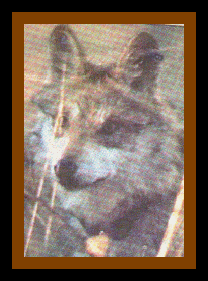
Gray Wolves' Uphill Battle

Gray Wolf Photo copyrighted by AP Photo
"There's nothing wrong with wolves", said Collins, a miner and coppersmith who lives in the hills near Silver City, New Mexico. " But I will shoot a wolf on sight, and I'd like the FBI tagging along. You are not going to tell me what to do". Collins' comments relect the deep rooted conflict of many who live along the Arizona-New Mexico line. They have mixed feelings about the federal government's year old program to repopulate the mountains of the Apache and Gila National Forests with endangered Mexican gray wolves. Many here say they are not so much against the wolves as they are against what the wolves represent. The erosion of a Western lifestyle dependent on mining, ranching and logging.
By 2005, government biologists plan to have 100 wolves in the 5,000 square mile wolf recovery zone (an area twice as big as Yellowstone National Park. By then, the reintroduction may have proved a success, and the wolves could be removed from the U.S. endangered species list. But since the arrival of the first 11 wolves in January 1998, five have been shot dead, a federal crime that carries a potential fine of $100,000 and a year in prison. A $50,000 reward has been offered for the capture of the wolf killers.
Despite the unsolved killings, Interior Secretary Bruce Babbitt, a former Arizona governor, said endangered Mexican gray wolves are here to stay. A new round of wolf releases this winter and spring will bring as many as 17 wolves to the state.(More than have lived here in half a century) Last week, a family of four wolves was released, but already, on Sunday, one of the pups was found dead; tests were being done to determine the cause.
Some experts believe that the wolves that were shot were mistaken for coyotes, though wolves are nearly three times larger. Coyotes are common targets in the Southwest. Many believe that killing coyotes mean more deer, elk, and antelope. But studies show that no matter how many coyotes are killed, they reproduce rapidly and quickly fill every ecological niche available.
Ironically, recent studies in Yellowstone National Park show that one way to effectively reduce coyotes is to introduce wolves. So they won't be mistaken for coyotes, officials are releasing the wolves this winter with brightly colored radio collars and painted marking on their hips.
Many of the rural residents who live in these mountains, where the jobless rate is high, see the return of the wolves as the latest intrusion by environmentalists and federal land managers. Timber production has fallen throughout Arizona and New Mexico, as the U.S. Forest Service spurred by environmentalists' lawsuits moves to comply with federal court orders aimed at saving dozen of species. Ranchers are under pressure from federal officials to cut their herds in areas where rivers and streams have been damaged by decades of overgrazing livestock.
Dave Parsons, Mexican gray wolf recovery leader for the U.S. Fish and Wildlife Service, said wolves have learned on their own to hunt wild game, mostly elk, which compete with cattle for forage. However, no sheep or cattle have been injured by wolves since they were set free last year. Of the original 11 wolves brought to Arizona last year, one is missing and presumed dead and three were recaptured for their own protection. In addition, the first Mexican wolf pup born in the wilds of Arizona in 50 years is missing and presumed dead. The reintroduction is a reversal by the government, which had, on behalf of ranchers, eliminated Mexican gray wolves in the United States in the 1970's.
Article listed in Newsday (March 25, 1999) By Steve Yozwiak who is an environmental reporter for the Arizona Republic.
(Copyright Rose 99)